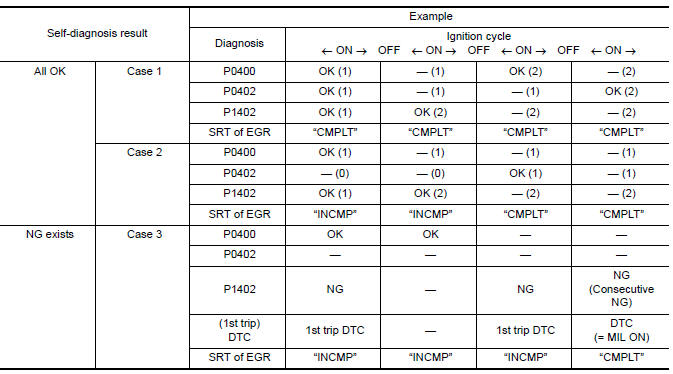Nissan Sentra Service Manual: Diagnosis description : system readiness test (SRT) code
System Readiness Test (SRT) code is specified in Service $01 of SAE J1979/ISO 15031-5.
As part of an enhanced emissions test for Inspection & Maintenance (I/M), certain states require the status of SRT be used to indicate whether the ECM has completed self-diagnosis of major emission systems and components.
Completion must be verified in order for the emissions inspection to proceed.
If a vehicle is rejected for a State emissions inspection due to one or more SRT items indicating –≤–Ç—öINCMP–≤–Ç—ú, use the information in this Service Manual to set the SRT to –≤–Ç—öCMPLT–≤–Ç—ú.
In most cases the ECM will automatically complete its self-diagnosis cycle during normal usage, and the SRT status will indicate –≤–Ç—öCMPLT–≤–Ç—ú for each application system. Once set as –≤–Ç—öCMPLT–≤–Ç—ú, the SRT status remains –≤–Ç—öCMPLT–≤–Ç—ú until the self-diagnosis memory is erased.
Occasionally, certain portions of the self-diagnostic test may not be completed as a result of the customer's normal driving pattern; the SRT will indicate –≤–Ç—öINCMP–≤–Ç—ú for these items.
NOTE:
The SRT will also indicate –≤–Ç—öINCMP–≤–Ç—ú if the self-diagnosis memory is erased for any reason or if the ECM memory power supply is interrupted for several hours.
If, during the state emissions inspection, the SRT indicates –≤–Ç—öCMPLT–≤–Ç—ú for all test items, the inspector will continue with the emissions test. However, if the SRT indicates –≤–Ç—öINCMP–≤–Ç—ú for one or more of the SRT items the vehicle is returned to the customer untested.
NOTE:
If permanent DTC is stored or MIL illuminates during the state emissions inspection, the vehicle is alsoreturned to the customer untested even though the SRT indicates –≤–Ç—öCMPLT–≤–Ç—ú for all test items. Therefore, it isimportant to check SRT (–≤–Ç—öCMPLT–≤–Ç—ú), DTC (No DTCs) and permanent DTC (NO permanent DTCs) before theinspection.
SRT SET TIMING
SRT is set as –≤–Ç—öCMPLT–≤–Ç—ú after self-diagnosis has been performed one or more times. Completion of SRT is done regardless of whether the result is OK or NG. The set timing is different between OK and NG results and is shown in the table below.

OK: Self-diagnosis is carried out and the result is OK.
NG: Self-diagnosis is carried out and the result is NG.
—: Self-diagnosis is not carried out.
When all SRT related self-diagnoses show OK results in a single cycle (Ignition OFF-ON-OFF), the SRT will indicate –≤–Ç—öCMPLT–≤–Ç—ú. → Case 1 above
When all SRT related self-diagnoses show OK results through several different cycles, the SRT will indicate –≤–Ç—öCMPLT–≤–Ç—ú at the time the respective self-diagnoses have at least one OK result. → Case 2 above If one or more SRT related self-diagnoses show NG results in 2 consecutive cycles, the SRT will also indicate –≤–Ç—öCMPLT–≤–Ç—ú. → Case 3 above The table above shows that the minimum number of cycles for setting SRT as –≤–Ç—öINCMP–≤–Ç—ú is the number one (1) for each self-diagnosis (Case 1 & 2) or the number two (2) for one of self-diagnoses (Case 3). However, in preparation for the state emissions inspection, it is unnecessary for each self-diagnosis to be executed twice (Case 3) for the following reasons:
- The SRT will indicate –≤–Ç—öCMPLT–≤–Ç—ú at the time the respective self-diagnoses have one (1) OK result.
- The emissions inspection requires –≤–Ç—öCMPLT–≤–Ç—ú of the SRT only with OK self-diagnosis results.
- During SRT driving pattern, the 1st trip DTC (NG) is detected prior to –≤–Ç—öCMPLT–≤–Ç—ú of SRT and the self-diagnosis memory must be erased from the ECM after repair.
- If the 1st trip DTC is erased, all the SRT will indicate –≤–Ç—öINCMP–≤–Ç—ú.
NOTE:
SRT can be set as –≤–Ç—öCMPLT–≤–Ç—ú together with the DTC(s). Therefore, DTC check must always be carried out prior to the state emission inspection even though the SRT indicates –≤–Ç—öCMPLT–≤–Ç—ú.
 Diagnosis description : driving pattern
Diagnosis description : driving pattern
DRIVING PATTERN A
Driving pattern A means a trip satisfying the following conditions.
Engine speed reaches 400 rpm or more.
Engine coolant temperature rises by 20В°C (36В°F) or more after s ...
 Diagnosis description : permanent diagnostic
trouble code (permanent DTC)
Diagnosis description : permanent diagnostic
trouble code (permanent DTC)
Permanent DTC is defined in SAE J1979/ISO 15031-5 Service $0A.
ECM stores a DTC issuing a command of turning on MIL as a permanent DTC and
keeps storing the DTC as
a permanent DTC until ECM judg ...
Other materials:
C1601 Battery power supply
DTC Logic
DTC DETECTION LOGIC
DTC
Display item
Malfunction detected condition
Possible cause
C1601
BATTERY VOLT
When a power supply voltage to the EPS control unit
is maintained at 17.5 V or more or at less than 9 V
continuously for five second or more.
...
Dtc/circuit diagnosis
Power supply and ground circuit
Audio unit
Audio unit : diagnosis procedure
Regarding wiring diagram information, refer to av-25, "wiring diagram".
1.Check fuse
Check that the following fuses are not blown.
Are the fuses blown?
Yes >> replace the blown fuse after repairing t ...
P1556, P1557 Battery temperature sensor
DTC Logic
DTC DETECTION LOGIC
NOTE:
If DTC P1556 or P1557 is displayed with DTC P0643, first perform the
trouble diagnosis for DTC P0643.
Refer to EC-353, "DTC Logic".
DTC No.
CONSULT screen terms
(Trouble diagnosis content)
DTC detecting condition
Possible caus ...
